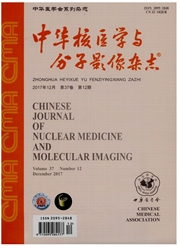

 中文摘要:
中文摘要:
纳米抗体作为一种新型抗体片段,保留了完整的抗原结合部位,具有相对分子质量小、特异性高、亲和力强等特性,非常适于构建分子探针用于分子影像。体外实验显示,以纳米抗体为基础的分子影像探针与抗原的亲和力可达到nmol水平。在肿瘤、动脉粥样硬化、神经系统疾病等的动物模型中,纳米抗体分子探针可高特异性地结合到靶器官,未结合的部分由肾脏迅速排泄,具有较高的靶/血液(T/B)比值,可清晰显示病变组织。经结构改造或化学修饰后,纳米抗体与靶器官的亲和力和滞留量进一步提高,更有利于其在分子影像中的应用。随着相关研究的不断深入,以纳米抗体为基础的分子影像在疾病早期诊断及疗效评估中的良好应用前景日渐突显。
 英文摘要:
英文摘要:
The nanobody is a novel antibody fragment, which has beneficial biophysical and phar- macokinetic properties, such as the small molecular weight, high affinity and specificity for antigen. Nanobody is ideally suitable for molecular imaging as a targeting probe that could label antigen at nmol level in vitro. In animal models of xenografted tumor, atherosclerotie plaques and brain disorders, the target tissues were specifically and clearly detected and the high tumor-to-blood (T/B) ratios were obtained. Stiuctural or chemical modified nanobodies will have higher affinity and retention to target tissues, and be convenient for the application of molecular imaging. With the development of the related research, nanobody-based molecu- lar imaging will be gradually transformed into the clinical applications, and play an important role in early diagnosis and therapeutic assessment.
 同期刊论文项目
同期刊论文项目
 同项目期刊论文
同项目期刊论文
 Prognostic predictive value of total lesion glycolysis from 18F-FDG PET/CT in post-surgical patients
Prognostic predictive value of total lesion glycolysis from 18F-FDG PET/CT in post-surgical patients Fluoine-18 fluorodeoxyglucose positron emission tomography-computed tomography in monitoring the res
Fluoine-18 fluorodeoxyglucose positron emission tomography-computed tomography in monitoring the res A Novel Technique for the Preparation of I-125-5-trimethylstannyl-1-(2-deoxy-2-fluoro-beta-D-arabino
A Novel Technique for the Preparation of I-125-5-trimethylstannyl-1-(2-deoxy-2-fluoro-beta-D-arabino Comparative study of cellular kinetics of reporter probe [I-131]FIAU in neonatal cardiac myocytes af
Comparative study of cellular kinetics of reporter probe [I-131]FIAU in neonatal cardiac myocytes af 期刊信息
期刊信息
